By Paul Thompson, CEO & Editor in Chief, Radio New Zealand
While the country has had its share of big news of late, including the devastating Christchurch earthquakes of 2010-11, we have no recent experience of mass violence targeted at a specific ethnic or religious community.
The last time was in very different circumstances in 1943 when 48 Japanese prisoners of war and one guard were killed near the town of Featherston. Details of the riot were sanitised and suppressed by war-time censorship.
In contrast, the attacks on the two Christchurch mosques were streamed and shared on social media and covered live on-air and online by media outlets around the world.
For this country it was an unprecedented, almost unthinkable, act of terrorism by a white supremist aimed at immigrants and Muslims. 50 people were killed and dozens wounded. The scale of loss and horror is still sinking in.
So how are we coping as news media with the complexity and enormity of telling the story of the atrocity and its aftermath?
And are we managing to reconcile the need for robust reporting of the facts with the need to ensure we do not create further harm by providing extremists with a platform, polarising the community or causing victims further harm?
From what I can see we are handling the first stage of the coverage well so far.
The focus has been on the victims and their unique personal stories
The focus has been on the victims and their unique personal stories and on the grief of their community, family and friends. There is also vital work being done on the serious issues raised by the attacks, including probing the performance of the security agencies and testing the received wisdom about New Zealand’s supposed high levels of tolerance for ethnic diversity.
The New Zealand news media’s performance has certainly been much better and more responsible than that of the global technology platforms, which appear all-pervasive and all-powerful yet are unwilling or unable to prevent their platforms being exploited by extremists.
Apart from a few early missteps, outlets here have decided not to publish or broadcast footage or audio of the atrocity or to publicise details of the shooter’s so-called manifesto.
Part of me feels challenged by a nagging sense that providers of news and current affairs should never work in formation like this.
But in this instance the uniform approach is appropriate. There will be plenty of time and opportunity in the future to delve into what happened in Christchurch utilising a range of reliable sources. That is when the deep, diverse reporting and divergent perspectives will rightly blossom. It will also include analysis that examines and demystifies the shooter’s manifesto.
News outlets are resisting pressure to follow Prime Minister Jacinda Ardern’s example of refusing to name the perpetrator, Brenton Tarrant.
That is the correct call. Suppression orders are for judges, not editors, to impose. His name is a known fact and should not be airbrushed out of sight. But there is no need to use the name repeatedly. A judicious approach is called for.
A second, more challenging, phase of the coverage is now beginning. This will be a long slog with coverage ongoing for years.
As an industry we need to take great care of these staff, not just now or next month but for the foreseeable future.
For some staff this will be hard, particularly those who witnessed the aftermath of the carnage and whose work brought them face-to-face with grieving families. One young RNZ journalist told me she had approached for comment about a dozen of the bereaved families in one day in Christchurch.
As an industry we need to take great care of these staff, not just now or next month but for the foreseeable future.
A commission of inquiry and a criminal trial lie ahead and will be the forums for a full accounting of the atrocity.
The news media will be determined to report these proceedings fully and robustly without becoming a mouthpiece for any hateful, extremist cause.
I have no doubt the New Zealand media will do a thoroughly professional job of covering the commission of inquiry and the criminal trial. The bigger risk is that some of the proceedings will be suppressed by the authorities under the guise of protecting national security. Officialdom in New Zealand has a propensity to try to keep embarrassing lapses from plain sight, as the frequent abuse of our Official Information Act shows.
That should be resisted. If mistakes have been made they need to be exposed. Otherwise, how can the public have confidence in the agencies charged with keeping them safe?
Looking ahead
Looking ahead, the shocking events in Christchurch bring to mind three major themes for the news media:
First, we are working in tumultuous times as forces including climate change, geopolitical shifts, political polarisation and the toxic effects of technology platforms shake the foundations of societies around the world. In the first three months of the year alone, New Zealand has been hit by a massive fire, a big flood and a massacre. This is the new normal and it is putting enormous pressure on newsroom resources at a time when most of the industry is in retreat. This creates a paradox – at the very time people most frequently need a range of reliable and well-resourced journalism, the industry is being hollowed out.
Second, democratic governments cannot ignore this problem. They must somehow find effective and affordable ways to support and nurture an independent and diverse media sector that has the capacity not only to provide accurate information in emergencies but also the heft needed to be a watchdog against corruption, cronyism and incompetence. Regulating the likes of Google and Facebook should be part of the solution but don’t hold your breath.
And finally, independent publicly-funded media such as RNZ should play a central role in this emerging news media ecosystem. Public media will rise to this challenge by maintaining the high quality, trusted and readily-accessible services that have always been our core purpose; and also by more overtly supporting under-pressure commercial media in practical ways, including by freely sharing publicly-funded content, nurturing talent and championing the importance of robust journalism.
As the Maori proverb says – He waka eke noa. As journalists, we are all in this together.
Paul Thompson is the CEO and Editor in Chief of Radio New Zealand, and President of the Public Media Alliance.
Header Image: One week on, people around the country honour the 50 victims of the Christchurch mosque terror attacks. March 22 2019. Credit: Radio New Zealand
Related Posts
1st November 2018
Insight | Disruption, Trust and the Public Broadcaster
President and CEO of CBC/Radio-Canada,…
19th January 2018
Insight | How public media should respond to journalism’s crisis
PMA President and Radio New Zealand CEO…



